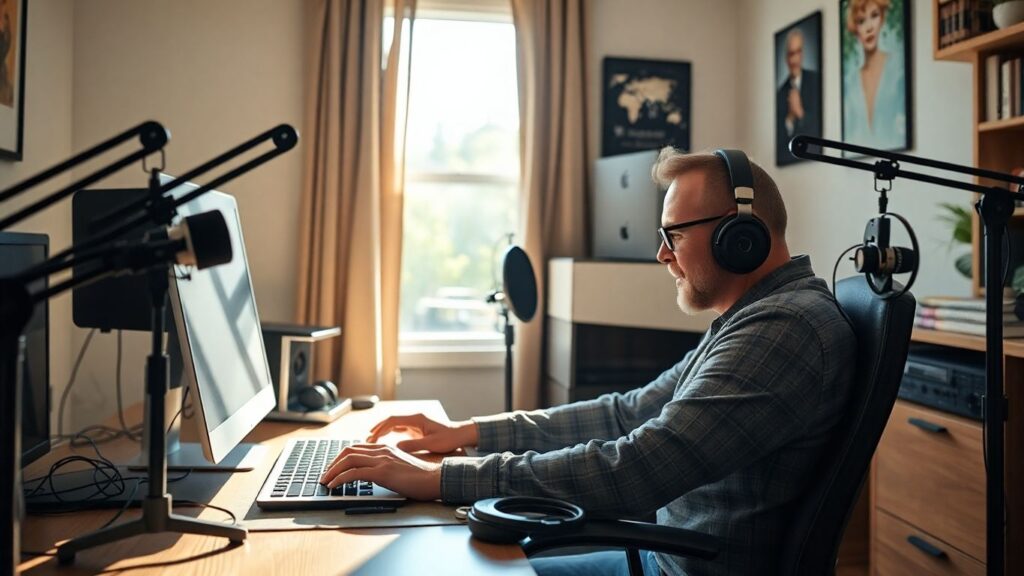Thinking about making some extra cash from home? You’re not alone. Lots of people are looking for ways to earn more without leaving the house. One good option is audio typing jobs, especially here in Australia. It’s not as complicated as it sounds, and with the right approach, you can find some decent work. This article will walk you through how to find these home audio typing jobs and make the most of them.
Key Takeaways
- There are plenty of legitimate home audio typing jobs available in Australia for those willing to look.
- Having good typing speed, accuracy, and listening skills are important for success in audio typing.
- Websites like Rev, TranscribeMe, and freelance platforms are good places to start searching for work.
- Understanding how you get paid and building a good reputation can help you earn more.
- Setting up a quiet workspace with the right tools will make your work easier and more productive.
Discovering Home Audio Typing Jobs In Australia

Understanding The Appeal Of Remote Typing Work
Working from home has really taken off, hasn’t it? For a lot of Aussies, the idea of earning a bit of extra cash without leaving the house is pretty appealing. Audio typing jobs fit right into this. You get to use skills you probably already have, like typing and listening, and turn them into income. It’s flexible, meaning you can often set your own hours, which is a lifesaver if you’ve got other commitments like family or study. Plus, you cut out the commute, saving time and money. It’s a straightforward way to earn, especially if you’re looking for something that doesn’t require a heap of specialised training to get started.
Identifying Legitimate Home Audio Typing Opportunities
Now, finding the real deals can be a bit tricky. The internet is full of opportunities, but not all of them are what they seem. You want to look for companies that are upfront about what they do and how they pay. Legitimate places usually have clear job descriptions and don’t ask for money upfront. Be wary of anything that sounds too good to be true, like promises of massive earnings for very little work. It’s a good idea to do a bit of digging on any company before you sign up. Check out reviews, see if they have a physical address or a proper business website.
Here are a few things to keep an eye out for:
- Clear communication: They explain the work, pay rates, and payment methods clearly.
- Reputable platforms: They often advertise on well-known job boards or have their own professional site.
- No upfront fees: Legitimate employers won’t ask you to pay for training or equipment before you start.
Navigating The Digital Landscape For Job Listings
So, where do you actually find these jobs? The internet is your best friend here. You’ll want to check out general job sites, but also look for platforms that specialise in freelance or remote work.
Think about:
- Dedicated transcription sites: These are companies that specifically hire people for audio typing.
- Freelance marketplaces: Websites where you can offer your services to various clients.
- General job boards: Sometimes, larger companies hire remote typists directly.
It’s worth setting up alerts on these sites so you get notified when new jobs pop up. You might also find opportunities through professional networks online, where people share job leads. The key is to be persistent and check regularly.
Finding legitimate work often comes down to a bit of research and knowing what red flags to avoid. Don’t rush into anything, and always trust your gut if something feels off. The right opportunity is out there if you look in the right places.
Essential Skills For Home Audio Typists
So, you’re keen to get into audio typing from home, eh? That’s grouse! But before you dive headfirst into transcribing podcasts or dictations, let’s chat about what you actually need to be good at. It’s not just about whacking away at a keyboard; there’s a bit more to it than that.
Mastering Typing Speed And Accuracy
This one’s pretty obvious, right? If you’re going to be typing up audio, you need to be able to type fast. We’re not talking about a casual pace here. Most places want you to be hitting at least 60 words per minute, and honestly, the faster the better. But speed isn’t everything. You can type a mile a minute, but if it’s full of typos and mistakes, it’s no good to anyone. Accuracy is king. You need to be able to get it right the first time, or at least close to it. Think about it – if you’re constantly having to go back and fix errors, you’re not actually saving any time, are you?
Here’s a rough idea of what’s generally expected:
| Skill | Minimum Target | Ideal Target |
|---|---|---|
| Typing Speed | 60 WPM | 80+ WPM |
| Accuracy | 98% | 99%+ |
Developing Active Listening And Comprehension
This is where it gets a bit more involved than just typing. You’ve got to actually listen to what’s being said. And not just hear the words, but understand them. This means picking up on accents, different speaking styles, and even background noise. Sometimes people mumble, or talk over each other, or there’s a dog barking in the background. You need to be able to tune all that out and still catch what’s important. It’s like being a detective for words. You’re piecing together sentences, figuring out who said what, and making sense of it all, even when it’s not crystal clear.
Cultivating Attention To Detail And Grammar
Once you’ve got the words down, you need to make sure they’re presented properly. This means paying attention to the nitty-gritty stuff. Are the commas in the right place? Is the spelling correct? Are you using the right tense? Different clients might have different style guides, too, so you’ll need to be adaptable. Some might want verbatim transcripts, meaning every single ‘um’ and ‘ah’ is included. Others want a cleaner version, where you tidy things up a bit. Either way, you’ve got to be sharp.
You’ll find that the better you get at spotting these small details, the quicker your work will be, and the happier your clients will be. It’s a win-win, really.
So, yeah, it’s more than just typing. You need speed, accuracy, good ears, and a keen eye for detail. But if you’ve got those, you’re well on your way to scoring some decent audio typing gigs.
Platforms And Resources For Finding Work
So, you’ve got the skills and you’re ready to start typing away from home. The next big question is, where do you actually find these audio typing jobs in Australia? Luckily, the internet is a pretty good place to start. There are heaps of websites and platforms out there designed to connect freelancers with clients looking for transcription services.
Top Websites For Home Audio Typing Jobs
Some sites are specifically set up for transcription work, which can be a good place to begin. These platforms often have a steady stream of work and understand the needs of transcriptionists. They might require you to pass a skills test before you can start taking on jobs, but that’s usually a good sign that the work is legitimate and the clients are serious.
- Rev: This is a really popular one for transcription. They have a decent amount of work and pay out regularly. You’ll need to do a test to get started.
- TranscribeMe: Another well-known platform that offers transcription jobs. They also have a testing process to ensure quality.
- GoTranscript: This site offers a variety of transcription services and is often looking for new typists to join their team.
Leveraging Freelance Marketplaces
Beyond the specialist transcription sites, there are also broader freelance marketplaces where you can find audio typing gigs. These platforms are huge and have clients posting jobs for all sorts of tasks, including transcription. The competition can be a bit higher here, but there’s also a wider range of potential clients and projects.
- Upwork: This is a massive platform where you can create a profile and bid on jobs. You’ll find everything from short audio clips to longer projects.
- Fiverr: Here, you can create ‘gigs’ offering your transcription services. Clients can then browse and purchase your services. It’s good for setting your own rates and packages.
- Freelancer: Similar to Upwork, you can bid on projects posted by clients. It’s another big player in the freelance world.
Utilising Social Media And Professional Networks
Don’t underestimate the power of your existing network or social media. Sometimes, the best jobs come from people you already know or connections you make online. LinkedIn, in particular, is a great place to connect with businesses and recruiters who might be looking for transcription services. You can also join Facebook groups dedicated to transcription or remote work in Australia. People often share job leads or tips in these communities.
Building a strong profile on these platforms is key. Make sure your skills are clearly listed, and if you have any previous work samples, have them ready to show. A good profile can make all the difference in landing your first few jobs and getting your home audio typing career off the ground.
Remember, it’s often a good idea to sign up for a few different platforms to see which ones work best for you and offer the most consistent work. Each has its own way of doing things, so exploring a few will help you find your groove.
Maximising Your Earnings With Audio Typing

So, you’ve got the skills and you’re ready to start earning. But how do you actually make the most money out of audio typing? It’s not just about taking any job that comes your way; it’s about being smart with your time and your rates.
Understanding Pay Structures And Rates
Most audio typing jobs pay in one of two ways: per audio minute or per hour worked. Per audio minute is pretty common for transcription work. This means you get paid for each minute of audio you transcribe, regardless of how long it takes you. Rates can vary wildly, from as little as $0.30 to over $2.00 per audio minute, depending on the complexity, audio quality, and turnaround time. Hourly rates are more common for ongoing projects or when you’re working directly for a client who wants to track your time. These can range from $20 to $50+ per hour, again, depending on your experience and the client’s budget.
It’s important to figure out your own effective hourly rate for per-audio-minute jobs. If a 10-minute audio file takes you an hour to transcribe and you’re paid $1 per audio minute, you’re actually only earning $10 an hour. If you can do it in 30 minutes, you’re earning $20 an hour. Knowing this helps you decide which jobs are truly worth your time.
Strategies For Increasing Your Hourly Earnings
Want to boost that income? There are a few tricks:
- Improve your typing speed and accuracy: The faster and more accurate you are, the more audio you can get through in less time. Practice regularly and consider touch-typing courses if you’re not already proficient.
- Invest in good equipment: A comfortable headset that cancels out background noise and a reliable computer are non-negotiable. Some typists also find foot pedals helpful for controlling playback, which can speed things up.
- Specialize in a niche: If you have knowledge in a particular field, like medical or legal terminology, you can often command higher rates for specialized transcription. This means you’re not just typing words; you’re understanding and accurately representing complex information.
- Take on rush jobs: Many platforms offer a bonus for faster turnaround times. If you can manage your workload, these urgent jobs can significantly increase your per-audio-minute earnings.
Building A Reputation For Reliable Work
Clients and platforms want to work with people they can trust. Consistently delivering high-quality work on time is the best way to build a good reputation. This can lead to:
- Higher-paying clients: Once you’ve proven yourself, clients are often willing to pay more for your reliability.
- Repeat business: Good clients will come back to you again and again, providing a steady stream of work.
- Positive reviews and ratings: On freelance platforms, good reviews mean more visibility and more job offers. You can find many audio typist roles on sites like SEEK.
Building a strong reputation isn’t just about completing tasks; it’s about professionalism. This includes clear communication, meeting deadlines, and always striving for accuracy. Over time, this dedication translates directly into better earning potential and more consistent work opportunities.
Remember, the more efficient and reliable you are, the more you can earn. It’s a straightforward equation in the world of audio typing.
Setting Up Your Home Office For Success
Alright, so you’ve decided to jump into the world of home audio typing jobs. That’s brilliant! But before you start taking on heaps of work, you’ve gotta make sure your workspace is set up right. It’s not just about having a computer; it’s about creating an environment where you can actually get stuff done efficiently and without pulling your hair out. Think of it as your command centre for earning cash.
Essential Equipment For Audio Transcription
First things first, let’s talk gear. You can’t transcribe audio if you can’t hear it properly or type fast enough. So, here’s a rundown of the must-haves:
- A reliable computer: Doesn’t need to be the latest and greatest, but it should be able to run your transcription software smoothly. Make sure it’s got a decent amount of storage too.
- Good quality headphones: This is super important. You need headphones that block out background noise and let you hear every little nuance in the audio. Over-ear ones are usually best for comfort during long sessions.
- A comfortable keyboard: You’ll be doing a lot of typing, so a keyboard that feels good under your fingers will make a huge difference. Some people prefer mechanical keyboards, others like the slim ones. Try a few out if you can.
- A foot pedal (optional but recommended): This little gadget lets you control audio playback with your foot – pause, rewind, fast-forward. It frees up your hands and speeds things up considerably. Seriously, it’s a game-changer for transcription.
- A stable internet connection: No one wants their work cut short because the internet dropped out. Make sure you’ve got a solid connection.
Creating A Productive And Quiet Workspace
Beyond the tech, the actual space you work in matters a lot. You want a spot where you can focus without distractions. This means:
- Minimising noise: If you live with others, chat to them about your work hours. If you’ve got noisy neighbours, consider some noise-cancelling headphones or even earplugs. A quiet space is key for accurate listening.
- Ergonomics: Set up your desk and chair so you’re comfortable. Your back and neck will thank you after a few hours. Make sure your screen is at eye level and your wrists are in a neutral position when typing.
- Good lighting: You don’t want to strain your eyes. Natural light is great if you can get it, but a good desk lamp is also a must.
- Keeping it tidy: A cluttered desk can lead to a cluttered mind. Try to keep your workspace organised. Have a place for everything so you’re not hunting for pens or chargers when you should be working.
Utilising Software And Tools For Efficiency
There’s a bunch of software out there that can make your audio typing life a whole lot easier. Using the right tools can seriously boost your output and accuracy.
- Transcription software: Many platforms provide their own software, but there are also standalone programs like Express Scribe or oTranscribe that offer features like hotkeys and audio playback control.
- Word processing software: Obviously, you’ll need something like Microsoft Word or Google Docs. Familiarise yourself with their shortcuts and features – things like spell check and grammar tools are your friends.
- Time tracking apps: If you’re paid by the hour or just want to keep an eye on how long tasks are taking you, apps like Toggl Track or Clockify can be really helpful.
- File management: Get organised with your audio files and completed transcripts. Use clear naming conventions and folders so you can find things easily. Cloud storage like Google Drive or Dropbox is handy for backups and accessing files from different devices.
Navigating Challenges And Ensuring Success
So, you’ve got the skills and you’re ready to start earning from home audio typing. That’s fantastic! But like any gig, there are a few bumps in the road you might hit. Let’s talk about how to get past them and keep things running smoothly.
Avoiding Common Scams In The Typing Industry
It’s a bit of a bummer, but there are definitely people out there trying to pull a fast one. You’ll see ads promising heaps of money for very little work, or asking you to pay for ‘starter kits’ or ‘training materials’ upfront. Legitimate companies won’t ask you for money to get a job. Always be wary of offers that sound too good to be true. Do your homework on any company before you sign up. Look for reviews, check their website, and see if they have a clear contact method. If they’re pushy or vague, it’s probably best to steer clear.
Managing Your Time Effectively
Working from home is great for flexibility, but it also means you’re your own boss when it comes to deadlines. It’s easy to get distracted by household chores, family, or just the lure of Netflix. To stay on track:
- Set a Schedule: Treat it like a real job. Decide on your working hours and stick to them as much as possible.
- Create a Dedicated Workspace: Even if it’s just a corner of a room, having a space that’s just for work helps you get in the zone.
- Use Productivity Tools: There are heaps of apps out there, like Trello or Asana, that can help you keep track of your tasks and deadlines.
- Take Regular Breaks: Don’t try to power through for hours on end. Short, regular breaks can actually make you more productive.
When you’re working remotely, the lines between work and life can get blurry. It’s up to you to draw those lines and make sure you’re not working all the time, or not working enough. Finding that balance is key to not burning out.
Continuous Learning And Skill Development
The world of work is always changing, and audio typing is no different. To keep your skills sharp and your earning potential high, make an effort to keep learning.
- Improve Your Typing Speed: Practice regularly. There are lots of free online typing tests and games that can help.
- Learn New Software: Familiarise yourself with different transcription software or tools that can make your work faster and more accurate. For example, learning keyboard shortcuts for transcription software can really speed things up.
- Stay Updated on Industry Trends: Keep an eye on what’s happening in the transcription world. Are there new types of audio files becoming common? Are there new technologies emerging? Knowing this can help you adapt and find new opportunities. You might even find new job listings on sites like Indeed.com that require specific skills you can learn.
By being aware of potential pitfalls and actively working on your skills, you can build a successful and rewarding career in home audio typing.
Ready to Start Typing Your Way to Extra Cash?
So, there you have it. Finding work typing from home in Australia isn’t some far-off dream anymore. With a bit of searching on the right job sites, you can find plenty of opportunities, whether you’re into data entry, writing, or transcribing. It’s a solid way to bring in some extra money without having to leave your house. Give it a go, see what fits, and start earning. You might be surprised at how much you can make just by using your keyboard.
Frequently Asked Questions (Australia)
What exactly is audio typing, and how can I do it from home in Australia?
Audio typing, also called transcription, is basically listening to audio recordings and typing out what’s being said. You can totally do this from your own home in Australia! All you really need is a computer, a good internet connection, and decent typing skills. Lots of companies are looking for people to type up things like interviews, meetings, or even lectures.
Do I need special skills or experience to start with audio typing jobs?
You don’t need a fancy degree or loads of experience to get started. The most important things are being able to type pretty quickly and accurately, and being a good listener. You’ll also need to pay attention to detail and have a good grasp of grammar to make sure what you type is spot on. Some places might offer a quick test to see if you’re up for it.
Where can I find these audio typing jobs in Australia?
There are heaps of places to look! Many websites specialise in freelance work, and you can search for ‘audio typist’ or ‘transcriptionist’. Social media groups and professional networking sites can also be good spots to find leads. Don’t forget to check out dedicated transcription company websites too – they often have a ‘careers’ or ‘work with us’ section.
How much money can I actually make doing audio typing from home?
The amount you earn can really vary. It often depends on how fast you type, how complex the audio is, and the company you’re working with. Some jobs pay by the audio minute, others by the hour. The more you practice and the better you get, the more you can earn. Building a good reputation for being reliable can also help you get more work and potentially higher rates.
What equipment do I need to set up a good home office for audio typing?
You’ll definitely need a reliable computer and a stable internet connection. A good pair of headphones is super important so you can hear the audio clearly, even if there’s background noise. Some people also find transcription software or a foot pedal really helpful for speeding things up, but you can often start with just the basics.
Are there any common scams I should watch out for when looking for typing jobs?
Yeah, unfortunately, there are a few dodgy characters out there. Be really wary of jobs that ask you to pay money upfront for training or software, or that promise ridiculously high pay for very little work. Always research the company before you sign up, and trust your gut if something feels a bit off. Legitimate companies won’t ask you to pay them.





